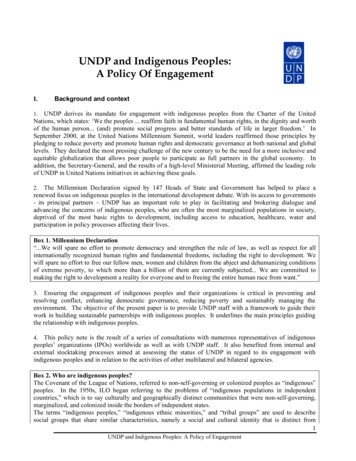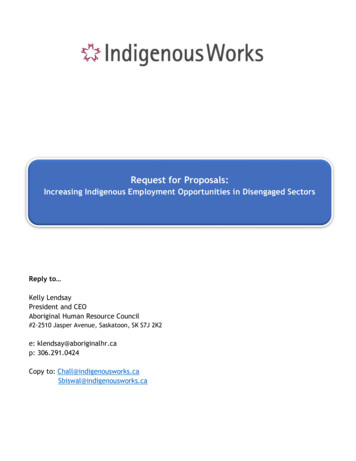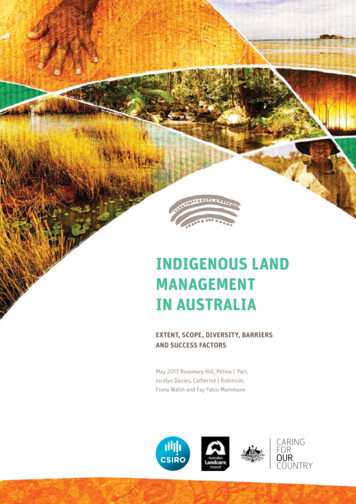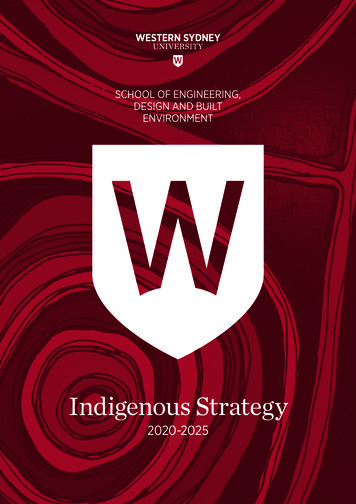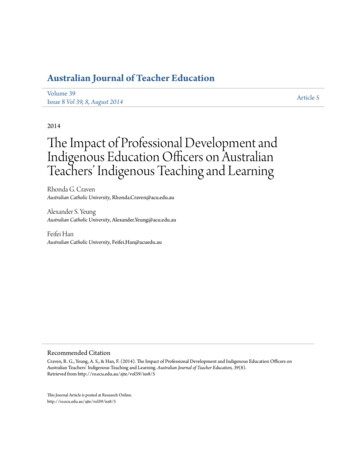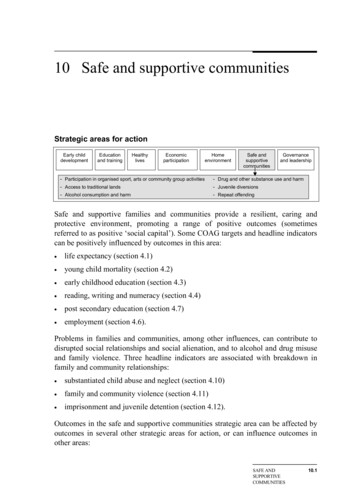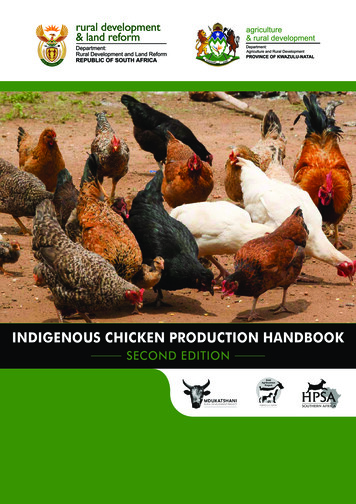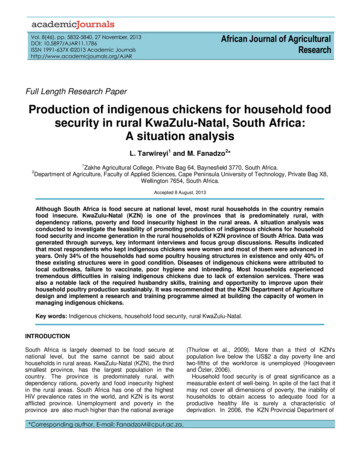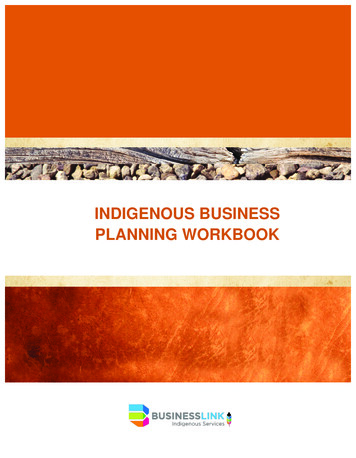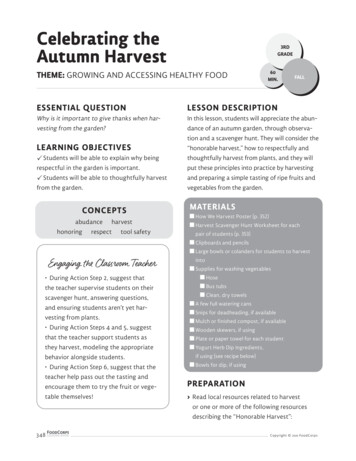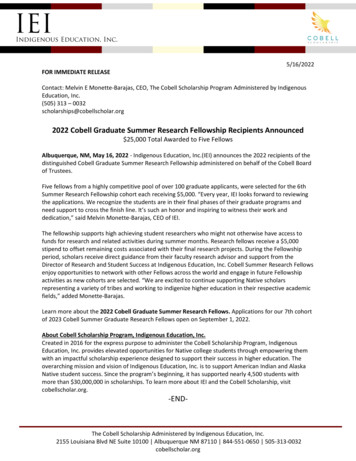
Transcription
IEIIndigenous Education, Inc.5/16/2022FOR IMMEDIATE RELEASEContact: Melvin E Monette-Barajas, CEO, The Cobell Scholarship Program Administered by IndigenousEducation, Inc.(505) 313 – 0032scholarships@cobellscholar.org2022 Cobell Graduate Summer Research Fellowship Recipients Announced 25,000 Total Awarded to Five FellowsAlbuquerque, NM, May 16, 2022 - Indigenous Education, Inc.(IEI) announces the 2022 recipients of thedistinguished Cobell Graduate Summer Research Fellowship administered on behalf of the Cobell Boardof Trustees.Five fellows from a highly competitive pool of over 100 graduate applicants, were selected for the 6thSummer Research Fellowship cohort each receiving 5,000. “Every year, IEI looks forward to reviewingthe applications. We recognize the students are in their final phases of their graduate programs andneed support to cross the finish line. It’s such an honor and inspiring to witness their work anddedication,” said Melvin Monette-Barajas, CEO of IEI.The fellowship supports high achieving student researchers who might not otherwise have access tofunds for research and related activities during summer months. Research fellows receive a 5,000stipend to offset remaining costs associated with their final research projects. During the Fellowshipperiod, scholars receive direct guidance from their faculty research advisor and support from theDirector of Research and Student Success at Indigenous Education, Inc. Cobell Summer Research Fellowsenjoy opportunities to network with other Fellows across the world and engage in future Fellowshipactivities as new cohorts are selected. “We are excited to continue supporting Native scholarsrepresenting a variety of tribes and working to indigenize higher education in their respective academicfields,” added Monette-Barajas.Learn more about the 2022 Cobell Graduate Summer Research Fellows. Applications for our 7th cohortof 2023 Cobell Summer Graduate Research Fellows open on September 1, 2022.About Cobell Scholarship Program, Indigenous Education, Inc.Created in 2016 for the express purpose to administer the Cobell Scholarship Program, IndigenousEducation, Inc. provides elevated opportunities for Native college students through empowering themwith an impactful scholarship experience designed to support their success in higher education. Theoverarching mission and vision of Indigenous Education, Inc. is to support American Indian and AlaskaNative student success. Since the program’s beginning, it has supported nearly 4,500 students withmore than 30,000,000 in scholarships. To learn more about IEI and the Cobell Scholarship, visitcobellscholar.org.-END-The Cobell Scholarship Administered by Indigenous Education, Inc.2155 Louisiana Blvd NE Suite 10100 Albuquerque NM 87110 844-551-0650 505-313-0032cobellscholar.org
IEIIndigenous Education, Inc.Cobell Fellow: Allison RamirezTribal Affiliation: Tohono O’odham NationInstitution: University of California Los AngelesDegree: PhD – SociologyResearch Project: Experience of the Tohono O’odham peoples inrelation to climate change and relationship(s) to water.Detailed Research Project Overview“The purpose of this research project is to understand howmembers of the Tohono O'odham Nation have experienced climatechange and drought conditions since 1999 in Tucson, Arizona. Todo this, Allison will interview 10 members of the Tohono O'odhamNation living in Tucson about their experiences with climatechanges by centering their stories on water and rain. Native peoples living off of Indian reservations areprovided less environmental protections for Native Americans living off of Indian reservations. Mydissertation research centers on two events of drought from 1940-64 and 1999-2020. Researchconcerning this proposal will examine the experiences of Tohono O'odham living in Tucson from 19992020. This research will help me complete the third chapter of my doctoral dissertation.Since 1999, the American Southwest has experienced prolonged and extreme drought conditions.Alongside prolonged drought conditions, the growing population of the American Southwest continuesto stress local water resources in desert metropolitan areas. Solutions for current and future droughtconditions facing metropolitan cities in the American Southwest have involved transporting water fromthe Colorado River Basin through infrastructures like the Central Arizona Project Aqueduct, droughtcontingency plans, and water settlements with local Native Nations. Native Nations themselves havetaken measures to mitigate the effects of climate change such as alternative energy projects (Redsteer2013:386).While the political efforts of Native Nations provide avenues for local climate adaptation, many Nativepeople live off of Indian reservations in cities and towns. This means that urban Native communities aresubject to the environmental laws and adaptation efforts of the jurisdiction they reside in, providingthem varied political experiences from Native communities that live within the jurisdictional boundariesof reservation land. Allison’s research aims to understand the experiences of Tohono O’odham withclimate change for social awareness and to help better serve urban Tohono O’odham communities andother urban Native communities facing the realities of climate change.To understand the environmental experiences of Tohono O’odham living in Tucson, Arizona, Allison willcomplete 10 semi-structured interviews. Interviews with Tohono O’odham living off the reservation willhelp us to understand how climate change impacts Native people living off of Indian reservations andreservation border towns has given environmental protections for Native people living in these spaces.To understand how Tohono O’odham living off the Tohono O’odham Nation’s reservations, this projectasks: “How does environmental change impact the lives of Tohono O’odham living in Tucson, Arizona?”and “How does their experience historically compare to those residing on the Tohono O’odham Nationgiven the lack of environmental and human projects for O’odham living off the reservation?”The Cobell Scholarship Administered by Indigenous Education, Inc.2155 Louisiana Blvd NE Suite 10100 Albuquerque NM 87110 844-551-0650 505-313-0032cobellscholar.org
IEIIndigenous Education, Inc.Like other Indigenous and non-Indigenous scholars who have followed the water as an object andmethod of analysis (Cattelino forthcoming; Curley 2021), this dissertation follows water to outline howclimate change has historically impacted Tohono O'odham life and kinship ties in times of drought.Research for this project does not involve any scientific sampling of water. This research for this projectwill require 15 burden hours from research participants, which they will be provided with a 30donation from their time. Research methods for this project align with the values and culture of theTohono O’odham nation rooted in kinship, respect, place-based ways of being, and wellness. If providedthe opportunity to receive the Cobell Graduate Summer Research Fellowship, she will use thisopportunity to build relationships with organizations and localities invested in Tohono O’odham life andenvironmental welling in Tucson, which she has had limited opportunity to do due to the Covid-19pandemic.Information from interviews will also be compiled in a written report to the Tohono O’odham Nationthat addresses the environmental and social needs of Tohono O’odham living in Tucson, Arizona. As alife-long member of Tucson’s Tohono O’odham community, information about the environmental andsocial conditions especially pertaining to environmental change and access to clean water couldcontribute to the wellbeing of this very resilient community.”Cobell Fellow: Ashton SmithTribal Affiliation: Apache Tribe of OklahomaInstitution: University of MontanaDegree: MA – Clinical PsychologyResearch Project: Indigenous culture, learning, and identity ineducational settingsDetailed Research Project Overview“Native American and Alaska Native (NA/AN) culture and identityare fundamental to their learning and well-being. The importance ofcultural and identity is particularly noted in the education system.For example, Isaacson et.al. (2018) found both NA/AN elders andyouth described the importance of learning within their educationsystems; yet, learning how to maintain their culture and traditionalvalues was vital for their well-being. Using Talking Circles, NA/ANyouth and elders explained the need for youth to be able to live within the Western world, whilemaintaining their culture and establishing their identity (Isaascon et.al., 2018). Specifically, some of thecomponents that shaped their identity were language, relationships, and education. Further, tribalelders shared in Talking Circles that they wanted their children to be educated, but during theireducation, they experienced negative relationships with the public education system due to the longlasting impacts of boarding schools on them and their families. Indeed, there was commonality in thatNA/AN people in contemporary society experience challenges to navigating two worlds withineducation.The Cobell Scholarship Administered by Indigenous Education, Inc.2155 Louisiana Blvd NE Suite 10100 Albuquerque NM 87110 844-551-0650 505-313-0032cobellscholar.org
IEIIndigenous Education, Inc.Learning and well-being are integral values for NA/AN people but finding an appropriate way toapproach education and learning can be difficult, especially when historically, the colonial-basedsystems have been created for NA/AN people to fail. Scholars (e.g., Fryberg, Covarubias, & Burack, 2013)have suggested that one way to engage NA/AN students in education is to have appropriaterepresentation of NA/AN people within school settings. This representation can include having NA/ANeducators and staff, textbooks that have accurate information of NA/AN histories, appropriatecurriculum for NA/AN youth, and cultural and language immersion (Aguilera & LeCompte, 2007;Northup & Withington, 2015).Another approach is to create spaces that support NA/AN students, making them feel welcome and safein schools. Many teachers are often taught child- or subject-centered approaches, but not taughtcommunity- or Indigenous-centered approaches that are more common in NA/AN communities(Castagno & Brayboy, 2008). Reyhner and Jacobs (2002) proposed that educators who work with NA/ANstudents can better prepare themselves by (1) being reflective and responsive in teaching, (2) criticallyconsidering pedagogical assumptions of the dominant culture, (3) increasing expectations for Nativestudents, (4) studying the concepts of spirituality and reciprocity, (4) focusing more on extended familyinvolvement in teaching and learning, (5) being sensitive to language issues on many levels, (6)understanding problems related to overusing extrinsic motivation, (7) realizing the importance ofcontinued teacher support, and (8) appreciating that the wisdom NA/AN cultures can benefit all children(Reyhner & Jacobs, 2002). Having teachers that are culturally aware and who can embody thesequalities and traits as an educator can contribute to NA/AN students feeling welcome and safe.Specifically, an approach to making schools feel safe and welcome for NA/AN students is integratingcultural matching and identity safety. Cultural matching has been conceptualized as having a child’sclassroom environment reflect their own culture at home (e.g., beliefs, values, traditions, language,dialect, shared experiences; Rip et.al., 2020). Identity safety, on the other hand, is conceptualized aswhen individuals believe that that their social identity is an asset, rather than a barrier to success in theclassroom, and that they are welcomed, supported, and valued whatever their background (Steele &Cohen-Vargas, 2013).Cultural matching and identity safety for NA/AN people in other environments (e.g., psychotherapy,child-welfare system, mentoring roles) have been found to support well-being and identity (Brown et.al.,2009; Ibaraki, Nagayama-Hall, 2014; Johnson et.al., 2019). Previous research studies have shown thatidentity safety and cultural matching are effective in promoting a sense of belonging in the classroomand eliminating stereotype threat for students of color, including African American and Hispanicstudents (Steele & Cohen-Vargas, 2013). Further, the existing research has found that cultural matchingcan have positive outcomes on foster placements for First Nation youth (Brown et.al., 2009). First Nationyouth in Canada need to have their own cultural framework within educational environments that isconsistent with the student’s culture for them to have higher grades and protection from discriminationand culture biases (Fryberg, et al., 2013). There is a gap in the research, however, specifically examiningcultural matching and identity safety for Native American and Alaska Native students in school.Although these studies examine cultural mismatching of education specifically for First Nation youth inCanada, there is a need to examine what components compose a culturally matched and identity safeclassroom for NA/AN students in the United States.The Cobell Scholarship Administered by Indigenous Education, Inc.2155 Louisiana Blvd NE Suite 10100 Albuquerque NM 87110 844-551-0650 505-313-0032cobellscholar.org
IEIIndigenous Education, Inc.The purpose of this study is to help identify culturally matched and identity safe practices that allow forNA/AN youth to feel safe within school settings. Although there are several ways in which people mayidentify this population (e.g., Indian, American Indian, Native American, Native), Ashton has chosen touse the term “Native American/Alaska Native” (NA/AN) to better reflect the contemporaryidentification, particularly because the alternative term, American Indian/Alaska Native, is used by theUS federal government and does not reflect her own identity. Importantly, NA/AN people identifythemselves with their affiliated tribe/tribes, and she will subsequently use the tribal affiliation whendescribing a research study or when discussing participants, committee members, and members of theresearch labs as appropriate. To address the aims of this study, Ashton will be using a Blackfeet, Kiowa,and Apache lens, while adhering to Niitsitipi (Blackfeet) values and worldview.”Cobell Fellow: James StumpffTribal Affiliation: Navajo NationInstitution: University of California - RiversideDegree: Cellular and Molecular BiologyResearch Project: Respiratory diseases and cellular correlations inIndigenous populationsDetailed Research Project Overview“Respiratory diseases disproportionately affect American Indian/AlaskaNative (AI/AN) populations which was recently highlighted by the SARSCoV-2 pandemic. Key determinants over the past decade of chronicrespiratory diseases disproportionately affecting AI/AN aresocioeconomic status (low-income housing), weight morbidity, andsmoking. Further health inequities were also highlighted during thepandemic as infection rates of COVID-19 were three and a half timeshigher in the Navajo Nation than that of white Americans. Seasonalinfluenza poses a threat despite current vaccinations, and we see AI/AN populations are at higher riskthan others for pneumonia and bronchitis, hospitalizations and death. His research focuses on hostresponses to influenza by identifying differences in cell populations and dynamics to find correlationswith mild or severe disease. Correlates with mild or severe disease can be targeted for therapeuticstrategies.James has identified innate immune cell populations that correlate with mild influenza diseaseoutcomes and are absent in severe disease. Current strategies combine computational, immunological,and virological techniques to predict and identify immune cells and their roles. His summer researchproject will further investigate and elucidate the role of these immune cells and how they help lungtissues restore homeostasis and promote healing.The pleural cavity surrounds the lungs and aids in breathing, however, there are an abundance ofimmune cells that reside within the cavity. Using computational data, we have predicted a population ofmacrophages that cross the mesothelium into the lung during the recovery phase of influenza. This hasbeen confirmed by staining these cells with a fluorescent dye (PKH26PCL) that can selectively label themacrophage population of cells. After infection mice are sacrificed and lungs are analyzed by flowThe Cobell Scholarship Administered by Indigenous Education, Inc.2155 Louisiana Blvd NE Suite 10100 Albuquerque NM 87110 844-551-0650 505-313-0032cobellscholar.org
IEIIndigenous Education, Inc.cytometry and confocal microscopy. Both methods use fluorescence to observe our cell population andquantify their abundance. Data also shows when these macrophages are ablated in influenza infection itleads to increased weight loss, indicating these macrophages have an important role either in recoveryor modulating the immune system during and after infection. Another aspect seen in mild influenza isalveolar macrophages do not decrease in number, but we see their numbers deplete significantly inmore severe disease. These macrophages are known to be “safeguards” of the airways as they areprimarily involved in clearing out pathogens that enter the airways. Another population namedinterstitial macrophages have two different subsets that reside in the lungs, and he has identified rapidexpansion of both populations during the recovery phase of influenza infection. Preliminary datasuggests a role in wound healing and immunomodulation. These three macrophage populations willfurther be investigated to elucidate how they responds to mild and severe disease, and what their role isduring infection and the recovery phase of restoring homeostasis.At his institution, James has access and been trained to use the high-containment BSL-3 with selectagents. This makes him uniquely suited to pursue a project of highly infectious influenza viruses. Jameswill compare a sub-lethal infection of seasonal influenza (H1N1) to a lethal infection of highly pathogenicavian influenza (H5N1). Mice will be used as a model and will be intranasally inoculated before beingsacrificed at multiple timepoints. Pathology will be determined by hematoxylin and eosin staining.Macrophage populations will be identified with immunofluorescent staining. Using Visium technology by10x Genomics the pathology can be overlayed with gene expression data to understand which genes areupregulated or downregulated in areas of chronic inflammation and damage or areas promoting woundhealing and recovery. Immunofluorescence will identify different macrophage populations and theirgene expression and distribution will be visualized by Visium. By understanding the contribution ofdifferent macrophage populations to the outcomes of infection we will elucidate new therapeutictargets. Dysregulated immune responses can be changed with different stimuli and macrophages can beactivated to promote healing or viral clearance. Gene expression can identify these targets andcorrelates.”The Cobell Scholarship Administered by Indigenous Education, Inc.2155 Louisiana Blvd NE Suite 10100 Albuquerque NM 87110 844-551-0650 505-313-0032cobellscholar.org
IEIIndigenous Education, Inc.Cobell Fellow: Shawna YazzieTribal Affiliation: Navajo NationInstitution: University of California – DavisDegree: PhD – American Indian/Native American StudiesResearch Project: Retelling and sharing of cultural knowledge throughweavingDetailed Research Project Overview“I am of the Big Water clan born for the Red Bottom clan. Mymaternal grandfathers are the Towering House clan. My paternalgrandfathers are the Tangle Peoples clan. I am a Diné woman. I amfrom A Body of Water in a Sunken Area [what is currently known asPinon, Arizona].Since time immemorial, Diné women of the Red Bottom Clan wovestories of survival through the practice of atł’ooh [rug weaving]. K’é[Diné Kinship System] is expressed in weaving as a record andrecognition of our practice of relating to and being responsible for each other through our clans. It isthrough our clan system that we find our place in the world as Diné. Our family still knows-feels thesignificance of rug weaving as an expression of K’é. In this case, my work with Diné women weavers’uplifts modes of storytelling -- the language in and surrounding -- the practice of rug weaving. Thispractice carries knowledge and teachings from time immemorial about how to exist in the world givenby Asdzáá Naashchéii [Spider Woman], who gifted rug weaving to Diné. More specifically, my projectshares how Diné women in A Body of Water in a Sunken Area build long-lasting connections to rugweaving to reclaim and heal themselves and their families, and to re-establish kinship ties that facilitateresponsible intergenerational transfers of knowledge for future generations. Kinship relations centersDiné Language as a core concept of understanding the cultural values inhibited in the loom, warp andtools attached to rug weaving. Through an intergenerational transfer of cultural knowledge, a cyclicalresponsibility gifted to me by my grandmother, I engage rug weaving as Diné women’s stories, truths,and remembrances.Broadly speaking, my research aims to amplify a range of Diné women’s histories and lived experiencesacross the Navajo Nation to counter dominant narratives that flatten the density of our Indigeneity.Grounded in my role as an apprentice weaver, my proposed project will focus on master weavers frommy home community to document the ways in which their practices embody Diné-specific theories andmethods of doing histories with, by and for Diné. This work is imperative as a Diné scholar to recenterhow knowledge is transferred to future generations while utilizing our own ways of knowing/being.Weaving is a way to live in balance in the Universe. I have experienced first-hand the ways in which rugweaving brings healing to Diné women and their families. My work shall bring healing by demonstratingthe ways in which our women’s works are vital to our community’s futurity. As a Diné woman, ourculture continues to be centered as being ‘lost’ or on the verge of being lost. Anthropologicalethnographic and linguistic studies of weaving tend to document Diné histories and practices in anextractive and linear fashion that do not follow Diné frameworks, and thus does not fully account forhow Diné theorize their cultural history and place in the world. My work does not propose to representall Navajo Nation or all Diné weavers across the land. Rather, my work serves as a call to Diné and non-The Cobell Scholarship Administered by Indigenous Education, Inc.2155 Louisiana Blvd NE Suite 10100 Albuquerque NM 87110 844-551-0650 505-313-0032cobellscholar.org
IEIIndigenous Education, Inc.Diné readers and future researchers alike to learn from a range of Diné weavers. Rather, my work seeksto allow future Indigenous scholars to explore their own community rug weaving histories.This documentation would follow two phases: first, to return home to speak with my relatives andsecond to edit the creation. Each of these educational principles model, Sa’ah Naagháí Bik’eh Hózhóón[SNBH], which places living in harmony. (I) Nitsáhákees [Thinking]. By the end of spring quarter 2022 Iwill have completed all of my coursework for my (1) PhD in Native American Studies (2) a DesignatedEmphasis in Feminist Theory and Research. This academic foundation will advance this project as myclasses taught me how to provide a critical lens and methods for integrating feminist perspectives andapproaches. (II) Nahat’á [Planning]. I will relocate to Pinon, Arizona for the entirety of summer 2022,which will necessitate quarantine to protect community members. (III) Iiná [Implementation]. I will thenbegin the process of engaging with community grandmothers through listening, talking, andremembering and what it is that they are willing to do and share. (IV) Siihasin Reflection/Assurance]. ByFall 2022, I will be ready to present and submit a final report that includes reflections and assuranceswith, by, and for the community.”Cobell Fellow: Timothy FishTribal Affiliation: Muscogee (Creek) NationInstitution: University of Wisconsin – MadisonDegree: PhD – Civil Society and Community ResearchResearch Project: A Case Study on the Reflections and LessonsLearned from Community-Led Initiatives Leading to the Construct ofthe Yungtun Language Proficiency Test using Narrative Inquiry.Detailed Research Project Overview“The purpose of this qualitative case study is to gather evidence onhow a group of Yup’ik educators, and other key stakeholders, cametogether to develop the Yungtun language proficiency test. Thiscase study will use a narrative inquiry methodology to capture thelived experiences of those involved, as it pertains to thedevelopment of the Yungtun language proficiency test.Timothy’s approach will look at how the collaborative efforts of theYup’ik tribal community, partnering organizations, and others pooled their resources, experience,knowledge, and skills together in order to convert and develop standardized language proficiencyinstruments into the Yup’ik worldview using Yup’ik epistemology and language. Roles and various levelsof influence and participation will be studied using surveys and in-depth interviews. Utilizing these datacollection techniques, knowledge and evidence will be gained to advance an understanding of howpertinent issues influenced the need to develop a culturally-relevant language proficiency instrumentthat authentically reflects the Yup’ik epistemology, how the developed research design by the Yup’ikcommunity of experts and partnering organizations came to be, how decisions were determined andconsensus achieved, and finally, how capacity building for those involved came together to achieve goalsset forth by this collaborative community of change agents. From existing research, it is well known thatparticipation in community-led research leads people from their respective ‘community’ to become co-The Cobell Scholarship Administered by Indigenous Education, Inc.2155 Louisiana Blvd NE Suite 10100 Albuquerque NM 87110 844-551-0650 505-313-0032cobellscholar.org
IEIIndigenous Education, Inc.researchers, or community researchers, researching issues and concerns that directly impact their placeof belonging and the people within their environment.Furthermore, participating organizational groups, and other partnerships, will be included in the study inorder to gain a better understanding of their unique partnership roles and contributions leading to thedevelopment of the Yungtun Language proficiency test and their response to the tribal communityneeds, desires, and ways of knowing and doing. From what is gathered, the Yup’ik tribal community andtheir partnering community organizations have developed a distinct relationship that has provensuccessful. Though successful, many challenges have been encountered along the way, as well asdifferences. These challenges and differences create many lessons to learn from that, if addressedappropriately, provide opportunities for learning, growth, innovation, and much needed support forAmerican Indian and Alaska Native English language learners.In summary, this qualitative case study will capture the story regarding the importance of preservingYup’ik heritage languages and culture, research approach and process, community inclusion, and thelived experiences from those who participated in this effort. It is my goal, as an Indigenous researcher,to capture and share this work through the voices of those involved in order to provide an accurate andauthentic account of their stories and contributions. It is my hope that this approach will speak to thevalidity and reliability that this work merits in order to gain an in-depth understanding of the situationand meaning from those involved. Timothy’s interest, as a researcher in this context, is in the processrather than the outcomes, in context rather than a specific variable, in discovery rather thanconfirmation. Lastly, the outcomes from this qualitative case study will bridge a research gap betweenwestern research canons and approaches to tribal community-led research initiatives through tribalresearch methods, practices, researchers, and support for American Indian and Alaska Native youth.”The Cobell Scholarship Administered by Indigenous Education, Inc.2155 Louisiana Blvd NE Suite 10100 Albuquerque NM 87110 844-551-0650 505-313-0032cobellscholar.org
period, scholars receive direct guidance from their faculty research advisor and support from the Director of Research and Student Success at Indigenous Education, Inc. Cobell Summer Research Fellows enjoy opportunities to network with other Fellows across the world and engage in future Fellowship activities as new cohorts are selected.
